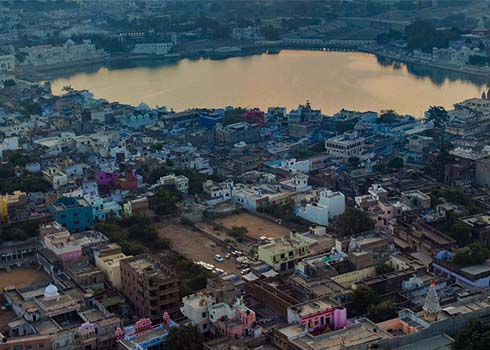Agra
Situated on the banks of Yamuna River, the city hosts many UNESCO World Heritage Sites including the Taj Mahal, one of the Seven Wonders of the World.
Traditions ascribe the foundation of the city of Agra to Raja Badal Singh around 1475 A.D. The city came into limelight during the rule of Afghan King Sikandar Lodhi - who had made it the capital of his empire. Agra has witnessed the rise of the pomp and pageantry of three great Mughal monarchs - Akbar, Jahangir and Shah Jahan. They transformed the land into one of the greatest centres of art, culture, learning and commerce. In modern times, the city of Agra is famous for its superb inlay work on marble, soapstone by craftsmen, carpets, gold thread embroidery and leather work.

Mathura
Mathura is a city in the North Indian state of Uttar Pradesh. It is located approximately 50 kilometres (31 mi) north of Agra.
Mathura is a sacred city in Uttar Pradesh, northern India. The deity Lord Krishna is said to have been born on the site of Sri Krishna Janma Bhoomi, a Hindu temple. Dotting the Yamuna River are 25 ghats (flights of steps down to the water), of which Vishram Ghat is considered the holiest. Sati Burj is a 16th-century memorial tower. Dwarkadhish Temple has a carved entrance and a black-marble idol of Lord Krishna.

Jaipur
The colourful city of Jaipur is one of India's first planned cities.
Bustling markets, historic buildings and hidden temples and oasis of peace set against the majestic backdrop of the Amer Fort make this a must visit city in Rajasthan.
Jaipur, founded by Maharaja Sawai Jai Singh II in 1727, is planned according to Indian Vastu Shastra. Jaipur is the only city in the world symbolizing the nine divisions of the Universe through nine rectangular sectors sub-dividing it. The city is steeped in history and culture. The palaces and forts of yesteryear that were witness to royal splendour and processions are now living monuments. Except for the busy traffic of bicycles, cars and buses, little seems to have changed. This fascinating city with its romantic charm takes you to an epoch of royalty and tradition.

Pushkar
Pushkar is one of the oldest cities in India. Located to the northwest of Ajmer, the tranquil city of Pushkar is a favoured destination for thousands of tourists and devotees flocking to Rajasthan.
Situated at a height of 510 metres, Pushkar is surrounded by hillocks on three sides. The ‘Nag Pahar’, literally meaning Snake Mountain forms a natural border between Ajmer and Pushkar. Known as ‘the rose garden of Rajasthan’, the essence of the famous Pushkar rose is exported all over the world. Along with an interesting mythological history, a legacy of timeless architectural heritage makes Pushkar a fascinating city.

Varanasi
Varanasi, the oldest living city in the world, is one of the seven sacred cities of the Hindus. More than a million pilgrims visit each year.
Varanasi is the spiritual capital of India. Also known in history as Kashi (City of Life) and Banaras by the British, Varanasi is an important pilgrimage centre for the Hindus. The city finds mention in the great epics of Mahabharata and Ramayana. It was a flourishing trade centre when Buddha came to Sarnath, to preach his first sermon in 500 BC. It is also a cherished name in the art of silk weaving. The Banarasi silk sarees and brocades are prized all over the world. The renowned American novelist Mark Twain once wrote: "Banaras is older than history, older than tradition older even than legend and looks twice as old as all of them put together".

Ranthambore
Ranthambore National Park is a vast wildlife reserve near the town of Sawai Madhopur in Rajasthan, northern India.
It is a former royal hunting ground and home to tigers, leopards and marsh crocodiles. Its landmarks include the imposing 10th-century Ranthambore Fort, on a hilltop, and the Ganesh Mandir temple. Also in the park, Padam Talao Lake is known for its abundance of water lilies.

Khajuraho
The Khajuraho Group of Monuments is a group of Hindu and Jain temples in Madhya Pradesh, India, about 175 kilometres (109 mi) southeast of Jhansi. They are one of the UNESCO World Heritage Sites in India.The temples are famous for their nagara-style architectural symbolism and their erotic sculptures.
Most Khajuraho temples were built between 950 and 1050 by the Chandela dynasty. Historical records note that the Khajuraho temple site had 85 temples by the 12th century, spread over 20 square kilometers Of these, only about 25 temples have survived, spread over 6 square kilometers. Of the various surviving temples, the Kandariya Mahadeva Temple is decorated with a profusion of sculptures with intricate details, symbolism and expressiveness of ancient Indian art.

Delhi
Delhi, India's capital territory, is a massive metropolitan area in the country's north.
In Old Delhi, a neighborhood dating to the 1600s, stands the imposing Mughal-era Red Fort, a symbol of India, and the sprawling Jama Masjid mosque, whose courtyard accommodates 25,000 people. Nearby is Chandni Chowk, a vibrant bazaar filled with food carts, sweets shops and spice stalls.
